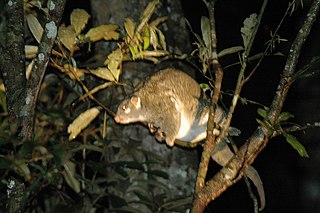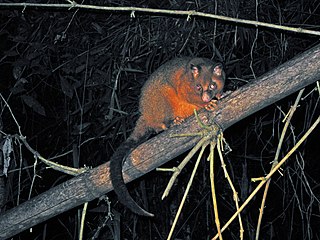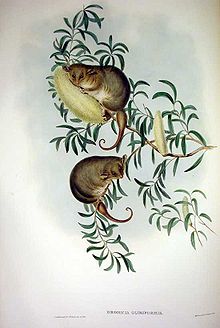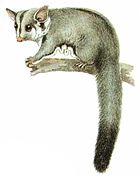
Phalangeriformes is a paraphyletic suborder of about 70 species of small to medium-sized arboreal marsupials native to Australia, New Guinea, and Sulawesi. The species are commonly known as possums, gliders, and cuscus. The common name "possum" for various Phalangeriformes species derives from the creatures' resemblance to the opossums of the Americas. However, although opossums are also marsupials, Australasian possums are more closely related to other Australasian marsupials such as kangaroos.

Diprotodontia is the largest extant order of marsupials, with about 155 species, including the kangaroos, wallabies, possums, koala, wombats, and many others. Extinct diprotodonts include the hippopotamus-sized Diprotodon, and Thylacoleo, the so-called "marsupial lion".

The common brushtail possum is a nocturnal, semi-arboreal marsupial of the family Phalangeridae, native to Australia, naturalised in New Zealand, and the second-largest of the possums.

The family Petauridae includes 11 medium-sized possum species: four striped possums, six species of wrist-winged gliders in the genus Petaurus and Leadbeater's possum, which has only vestigial gliding membranes. Most of the wrist-winged gliders are native to Australia, most of the striped possums to New Guinea, but some members of each are found on both sides of the Torres Strait.

Australidelphia is the superorder that contains roughly three-quarters of all marsupials, including all those native to Australasia and a single species from South America. All other American marsupials are members of the Ameridelphia. Analysis of retrotransposon insertion sites in the nuclear DNA of a variety of marsupials has shown that the South American monito del monte's lineage is the most basal of the superorder.

Fat Possum Records is an American independent record label based in Water Valley and Oxford, Mississippi. At first Fat Possum focused almost entirely on recording previously unknown Mississippi blues artists. Recently, Fat Possum has signed younger rock acts to its roster. The label has been featured in The New York Times, New Yorker, The Observer, a Sundance Channel production, features on NPR, and a 2004 documentary, You See Me Laughin. Fat Possum also distributes the Hi Records catalog.

Pseudocheiridae is a family of arboreal marsupials containing 17 extant species of ringtailed possums and close relatives. They are found in forested areas and shrublands throughout Australia and New Guinea.

The pygmy possums are a family of small possums that together form the marsupial family Burramyidae. The five extant species of pygmy possum are grouped into two genera. Four of the species are endemic to Australia, with one species also co-occurring in Papua New Guinea and Indonesia.

The genus Cercartetus is a group of very small possums known as pygmy possums. Four species comprise this genus, which together with the genus Burramys make up the marsupial family Burramyidae.

The rock-haunting ringtail possum, also known as the rock ringtail possum, is a species of Australian possum. It is found in rocky escarpments in the Kimberley, Arnhem Land and Gulf of Carpentaria across Western Australia and Northern Territory and just passing the Queensland border. It is also found on Groote Eylandt. It the only species in the genus Petropseudes, but is part of the group including the common ringtail possum.

The Woodlark cuscus is a species of marsupial in the family Phalangeridae endemic to Papua New Guinea, specifically on Madau and Woodlark Island, a part of the Milne Bay Province of Papua New Guinea. It happens to be the largest mammal living on Woodlark Island but it is also found on the neighboring island of Alcester, 70 kilometers south of Woodlark Island.

The northern common cuscus, also known as the grey cuscus, is a species of marsupial in the family Phalangeridae native to northern New Guinea and adjacent smaller islands, but is now also found in the Bismarck Archipelago, southeast and central Moluccas, the Solomons, and Timor, where it is believed to have been introduced in prehistoric times from New Guinea. It was formerly considered conspecific with the allopatric P. intercastellanus and P. mimicus.

False ringtail possum (Pseudochirops) is a genus of marsupial in the family Pseudocheiridae. It contains the following species:
Slender ringtail possum or Small ringtail possum (Pseudochirulus), also known as the ringtail possum, is a genus of marsupial in the family Pseudocheiridae native to Indonesia, Papua New Guinea and Queensland, Australia. Pseudochirulus live on trees and their diet mainly consists of leaves. The ringtail possums are related to five other genera Hemibelideus, Petauroides, Petropseudes, Pseudocheirus and Pseudochirops.

The brushtail possums are the members of the genus Trichosurus in the Phalangeridae, a family of marsupials. They are native to Australia and some small nearby islands. Unique among marsupials, they have shifted the hypaxial muscles from the epipubic to the pelvis, much like in placental muscles, meaning that their breathing cycle is more similar to the latter than to that of other non-eutherian mammals. In general, they are more terrestrially oriented than other possums, and in some ways might parallel primates.

The mountain brushtail possum, or southern bobuck, is a nocturnal, semi-arboreal marsupial of the family Phalangeridae native to southeastern Australia. It was not described as a separate species until 2002.

Petauroidea is a superfamily of marsupials from Australia and New Guinea. It is part of the suborder Phalangeriformes within the order Diprotodontia, which also includes, among others, wombats, kangaroos, cuscuses. The superfamily Phalangeroidea, including cuscuses and brushtail possums and pygmy possums, is the immediate sister group of the Petauroidea.

The coppery brushtail possum is a species of marsupial possum in the family Phalangeridae. Coppery brushtails are found within the Atherton Tablelands area of Queensland, in northeastern Australia. These mammals inhabit rainforest ecosystems, living within the tree canopy. Though they have a restricted distribution, they are locally common. This population is often considered a subspecies of T. vulpecula.


















